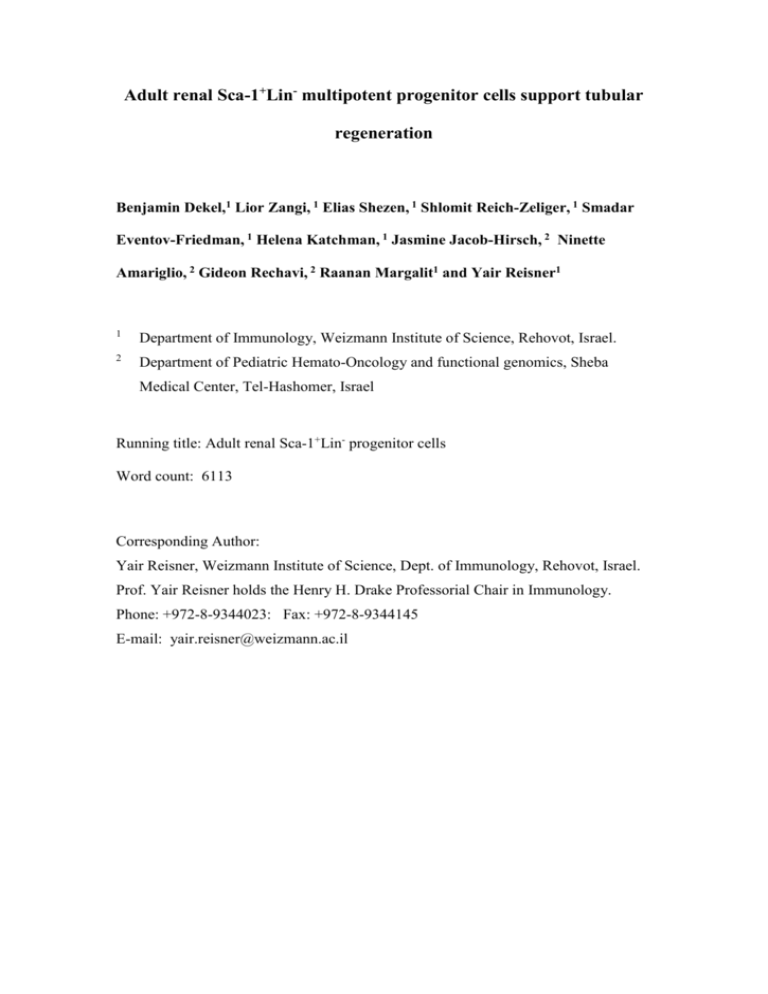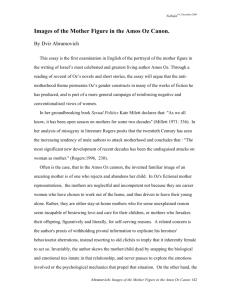Adult renal Sca-1+Lin- multipotent progenitor cells support tubular
advertisement

Adult renal Sca-1+Lin- multipotent progenitor cells support tubular regeneration Benjamin Dekel,1 Lior Zangi, 1 Elias Shezen, 1 Shlomit Reich-Zeliger, 1 Smadar Eventov-Friedman, 1 Helena Katchman, 1 Jasmine Jacob-Hirsch, 2 Ninette Amariglio, 2 Gideon Rechavi, 2 Raanan Margalit1 and Yair Reisner1 1 Department of Immunology, Weizmann Institute of Science, Rehovot, Israel. 2 Department of Pediatric Hemato-Oncology and functional genomics, Sheba Medical Center, Tel-Hashomer, Israel Running title: Adult renal Sca-1+Lin- progenitor cells Word count: 6113 Corresponding Author: Yair Reisner, Weizmann Institute of Science, Dept. of Immunology, Rehovot, Israel. Prof. Yair Reisner holds the Henry H. Drake Professorial Chair in Immunology. Phone: +972-8-9344023: Fax: +972-8-9344145 E-mail: yair.reisner@weizmann.ac.il Abstract Tissue engineering and cell therapy approaches aim to take advantage of the repopulating ability and plasticity of multipotent stem cells to regenerate lost or diseased tissue. Recently, we used stage-specific embryonic kidney progenitor tissue to regenerate nephrons. Through fluorescence-activated cell sorting, microarray analysis, in vitro differentiation assays, mixed lymphocyte reaction and a model of ischemic kidney injury, we sought to identify and characterize multipotent organ stem/progenitor cells in the developing and adult kidney. Here, we report the existence of adult kidney – derived renal progenitor cells expressing stem cell antigen – 1 (Sca-1) but lacking hematopoietic stem cell and lineage markers. These cells, which are typically negative for pan-cytokeratin, predominantly localize to the interstitium of the renal papillae, a presumed adult kidney stem cell niche. Global gene profiling reveals enrichment for many genes down-stream to developmental signaling molecules and self-renewal pathways, such as TGF/BMP, Wnt or FGF, as well as for those involved in specification of mesodermal lineages (MEF2A, YAF2, filamin). In vitro, they are plastic adherent, slowly proliferating, and result in inhibition of alloreactive CD8+ T cells, indicative of an immune-privileged behavior. Furthermore, clonal–derived lines can be differentiated into myogenic, osteogenic, adipogenic and neural lineages. Finally, when injected directly into the renal parenchyma, shortly after ischemic/reperfusion injury, renal Sca-1+Lin- cells, derived from ROSA26 reporter mice, adopt a tubular phenotype, and contribute to kidney repair. Our data define a unique phenotype for adult kidney derived cells, which have potential as stem cells and may contribute to the regeneration of injured kidneys.









